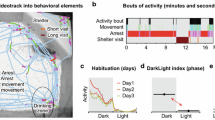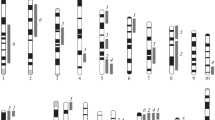Abstract
A genetic analysis of morphine-induced analgesia and activity was conducted in mice belonging to the strains BALB/cJ, C57BL/6J, DBA/2J and to their F1 and backcross progenies. The results support previous findings showing that a negative correlation is evident between these two behavioral measures and support that their mode of inheritance is characterized by dominance or partial dominance. The biometric analysis conducted on the parental, F1 hybrid and backcross populations indicates very clearly that the effects of morphine are genetically determined.
Similar content being viewed by others
References
Bruell, J. H.: Dominance and segregation in the inheritance of quantitative behavior in mice. In: Roots of behavior. E. L. Bliss, ed. New York: Harper & Row 1962
Castellano, C., Espinet Llovera, B., Oliverio, A.: Morphine reduced running and analgesia in two strains of mice following septal lesions or modification of brain amines. Arch. Pharmacol. (in press 1975)
Eddy, N. B., Leimback, D.: Synthetic analgesics. II. Dithienylbutenyl- and dithienylbutylamines. J. Pharmacol. exp. Ther. 107, 385–393 (1953)
Eriksson, K., Kiianmaa, K.: Genetic analysis of susceptibility to morphine addiction in inbred mice. Ann. Med. exp. Fenn. 49, 73–78 (1971)
Goldstein, A., Sheehan, P.: Tolerance to opioid narcotics. I. Tolerance to the “running fit” caused by Levorphanol in the mouse. J. Pharmacol. exp. Ther. 169, 175–184 (1969)
Mather, K.: Biometrical genetics: The study of continuous variation. London: Methuen 1949
Nichols, J. R., Hsiao, S.: Addiction liability of albino rats: breeding for quantitative differences in morphine drinking. Science 157, 561–563 (1967)
Oliverio, A., Castellano, C.: Genotype dependent sensitivity and tolerance to morphine and heroine: dissociation between opiate-induced running and analgesia in the mouse. Psychopharmacologia (Berl.) 39, 13–22 (1974)
Oliverio, A., Castellano, C., Messeri, P.: Genotype dependent effects of septal lesions on different types of learning in the mouse. J. comp. physiol. Psychol. 82, 240–246 (1973)
Winter, C. A., Flataker, L.: The effect of cortisone, desoxycorticosterone, and adreno-corticotropic hormone upon the responses of animals to analgesic drugs. J. Pharmacol. exp. Ther. 103, 93–105 (1951)
Author information
Authors and Affiliations
Rights and permissions
About this article
Cite this article
Castellano, C., Oliverio, A. A genetic analysis of morphine-induced running and analgesia in the mouse. Psychopharmacologia 41, 197–200 (1975). https://doi.org/10.1007/BF00428924
Received:
Revised:
Issue Date:
DOI: https://doi.org/10.1007/BF00428924




